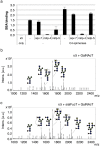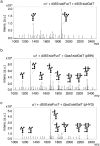Production and glyco-engineering of immunomodulatory helminth glycoproteins in plants
- PMID: 28393916
- PMCID: PMC5385521
- DOI: 10.1038/srep45910
Production and glyco-engineering of immunomodulatory helminth glycoproteins in plants
Abstract
Helminth parasites control host-immune responses by secreting immunomodulatory glycoproteins. Clinical trials and mouse model studies have demonstrated the potential of helminth-derived glycoproteins for the treatment of immune-related diseases, like allergies and autoimmune diseases. Studies are however hampered by the limited availability of native parasite-derived proteins. Moreover, recombinant protein production systems have thus far been unable to reconstitute helminth-like glycosylation essential for the functionality of some helminth glycoproteins. Here we exploited the flexibility of the N-glycosylation machinery of plants to reconstruct the helminth glycoproteins omega-1 and kappa-5, two major constituents of immunomodulatory Schistosoma mansoni soluble egg antigens. Fine-tuning transient co-expression of specific glycosyltransferases in Nicotiana benthamiana enabled the synthesis of Lewis X (LeX) and LDN/LDN-F glycan motifs as found on natural omega-1 and kappa-5, respectively. In vitro and in vivo evaluation of the introduction of native LeX motifs on plant-produced omega-1 confirmed that LeX on omega-1 contributes to the glycoprotein's Th2-inducing properties. These data indicate that mimicking the complex carbohydrate structures of helminths in plants is a promising strategy to allow targeted evaluation of therapeutic glycoproteins for the treatment of inflammatory disorders. In addition, our results offer perspectives for the development of effective anti-helminthic vaccines by reconstructing native parasite glycoprotein antigens.
Conflict of interest statement
The authors declare no competing financial interests.
Figures





Similar articles
-
Targeted glycoproteomic analysis reveals that kappa-5 is a major, uniquely glycosylated component of Schistosoma mansoni egg antigens.Mol Cell Proteomics. 2011 May;10(5):M110.005710. doi: 10.1074/mcp.M110.005710. Epub 2011 Mar 3. Mol Cell Proteomics. 2011. PMID: 21372247 Free PMC article.
-
Functional characterization of Schistosoma mansoni fucosyltransferases in Nicotiana benthamiana plants.Sci Rep. 2020 Oct 28;10(1):18528. doi: 10.1038/s41598-020-74485-z. Sci Rep. 2020. PMID: 33116178 Free PMC article.
-
Structural characterization of glycans on omega-1, a major Schistosoma mansoni egg glycoprotein that drives Th2 responses.J Proteome Res. 2010 May 7;9(5):2630-42. doi: 10.1021/pr100081c. J Proteome Res. 2010. PMID: 20178377
-
Schistosoma mansoni egg glycoproteins and C-type lectins of host immune cells: molecular partners that shape immune responses.Exp Parasitol. 2012 Sep;132(1):14-21. doi: 10.1016/j.exppara.2011.05.005. Epub 2011 May 15. Exp Parasitol. 2012. PMID: 21616068 Review.
-
Glyco-Engineering Plants to Produce Helminth Glycoproteins as Prospective Biopharmaceuticals: Recent Advances, Challenges and Future Prospects.Front Plant Sci. 2022 Apr 29;13:882835. doi: 10.3389/fpls.2022.882835. eCollection 2022. Front Plant Sci. 2022. PMID: 35574113 Free PMC article. Review.
Cited by
-
Development of Plant-Based Vaccines for Prevention of Avian Influenza and Newcastle Disease in Poultry.Vaccines (Basel). 2022 Mar 19;10(3):478. doi: 10.3390/vaccines10030478. Vaccines (Basel). 2022. PMID: 35335110 Free PMC article. Review.
-
Helminth Glycans at the Host-Parasite Interface and Their Potential for Developing Novel Therapeutics.Front Mol Biosci. 2022 Jan 10;8:807821. doi: 10.3389/fmolb.2021.807821. eCollection 2021. Front Mol Biosci. 2022. PMID: 35083280 Free PMC article. Review.
-
Advanced Plant-Based Glycan Engineering.Front Bioeng Biotechnol. 2018 Jun 14;6:81. doi: 10.3389/fbioe.2018.00081. eCollection 2018. Front Bioeng Biotechnol. 2018. PMID: 29963553 Free PMC article. Review.
-
Editorial: Plant Glycobiology - A Sweet World of Glycans, Glycoproteins, Glycolipids, and Carbohydrate-Binding Proteins.Front Plant Sci. 2021 Sep 3;12:751923. doi: 10.3389/fpls.2021.751923. eCollection 2021. Front Plant Sci. 2021. PMID: 34539724 Free PMC article. No abstract available.
-
Schistosome egg antigens, including the glycoprotein IPSE/alpha-1, trigger the development of regulatory B cells.PLoS Pathog. 2017 Jul 28;13(7):e1006539. doi: 10.1371/journal.ppat.1006539. eCollection 2017 Jul. PLoS Pathog. 2017. PMID: 28753651 Free PMC article.
References
-
- Tundup S., Srivastava L. & Harn D. A. Jr. Polarization of host immune responses by helminth-expressed glycans. Annals of the New York Academy of Sciences 1253, E1–E13 (2012). - PubMed
Publication types
MeSH terms
Substances
LinkOut - more resources
Full Text Sources
Other Literature Sources

